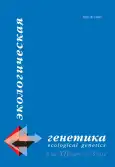Inheritance of acaricide resistance in inbreeding lines of two-spotted spider mite
- Authors: Sundukov O.V.1, Tulayeva I.A.1, Zubanov Y.A.1
-
Affiliations:
- All-Russian institute for plant Protection
- Issue: Vol 12, No 3 (2014)
- Pages: 43-51
- Section: Articles
- URL: https://journals.rcsi.science/ecolgenet/article/view/2424
- DOI: https://doi.org/10.17816/ecogen12343-51
- ID: 2424
Cite item
Full Text
Abstract
Keywords
Full Text
##article.viewOnOriginalSite##About the authors
Oleg Veniaminovich Sundukov
All-Russian institute for plant Protection
Email: Sunduckov.oleg@yandex.ru
PhD, Senior scientist. Laboratory ecotoxicology
Irina Anatolyevna Tulayeva
All-Russian institute for plant Protection
Email: zubanov63@yandex.ru
PhD, scientist. Laboratory ecotoxicology
Yevgeniy Aleksandrovich Zubanov
All-Russian institute for plant Protection
Email: zubanov63@yandex.ru
PhD, scientist. Laboratory ecotoxicology
References
- Беленький М. Л. (1959) Элементы количественной оценки фармакологического эффекта. Рига: АН ЛССР.
- Сундуков О. В. (2012) Этиология острой токсичности инсектоакарицидов и физиологические факторы, определяющие избирательность их действия на членистоногих. СПб.: Наука.
- Урбах В. Ю. (1964) Биометрические методы. М.: Наука.
- Bass Ch., Field L. M. (2011) Gene amplification and insecticide resistance. Pest Manag. Sci. V. 67(8): P. 886-890.
- Bloomquist J. R. (2003) Chloride channels as tools for developing selective insecticides. Arch. Insect Biochem. Physiol. V.54(4): P. 145-156.
- Burton M. J., Mellor I. R., Duce I. R. et al. (2011) Differential resistance of insect sodium channels with kdr mutations to deltamethrin and DDT. Insect Biochem. Mol. Biol. V. 41: P. 723-732.
- Clark J. M., Scott J. G., Campos F., Bloomquist J. R. (1995) Resistance to avermectins - extent, mechanisms and management implications. Annu. Rev. Entomol. V. 40: P. 1-30.
- Cui F., Lin Z., Wang H. et al. (2011) Two single mutations commonly cause qualitative change of nonspecific carboxylesterases in insects. Insect Biochem. Mol. Biol. V. 41: P. 1-8.
- Dermauw W., Ilias A., Riga M. et al. (2012) The cys-loop ligand-gated ion channel gene family of Tetranychus urticae: Implications for acaricide toxicology and novel mutation associaned with abamectin resistance. Insect Biochem. Mol. Biol. V. 42: P. 455-465.
- Devonshire A. L., Field L. M. (1991) Gene amplification and insecticide resistance. Annu. Rev. Entomol. V. 36: P. 1-23.
- Devorshak C., Roe R. M. (1998) The role of esterases in insecticide resistance. Rev. Toxicol. V. 2: P. 501-537.
- Feyereisen R. (2005) Insect cytochrome P450. Compreh. Molec. Insect Sci. V. 5: P. 1-77.
- Field L. M., Foster S. P. I. (2002) Amplified esterase genes and their relationship with insecticide resistance mechanisms in English field populations of the aphid, Myzus persicae (Sulzer). Pest Manag. Sci. V. 58(9): P. 889-894.
- Goh D. K. S., Anspaugh D. D., Motoyama N. et al. (1995) Isolation and characterization of an insecticide resistant associated esterase in the tobacco budworm Heliothios virescens (F.). Pest. Biochem. Physiol. V. 5: P. 192-204.
- Gunning R. V., Moores G. D., Jtwess Ph. et al. (2007) Use of pyrethroid analogues to identity key structural features for enhanced esterase resistance in Helicoverpa armigera (Hubner) (Lepidoptera: Noctuidae). Pest Manag. Sci. V. 63 (6): P. 569-575.
- Kwon D. H., Yoon K. S., Clark J. M., Lee S. H. (2010) A point mutation in a glutamate-gated chloride channel confers abamectin resistance in the two-spotted spider mite, Tetranychus urticae Koch. Insect Mol. Biol. V. 19: P. 583-591.
- Leeuwen T. van, Pottelberge S. van, Tirri L. (2005) Comparative acaricide susceptibility and detoxifying enzyme activities in field-collected resistant and susceptible strains of Tetranychus urticae. Pest Manag. Sci. V. 61(5): P. 499-507.
- Leeuwen T. van, Tirry L. (2007) Esterase-mediated bifenthrin resistance in a multiresistant strain of the two-spotted spider mite, Tetranychus urticae. Pest Manag. Sci. V. 63(2): P. 150-156.
- Leeuwen T. van, Vontas J., Tsagkarakou A. et al. (2010) Acaricide resistance mechanisms in the two-spotted spider mite Tetranychus urticae and other important Acari: A review. Insect Biochem. Mol. Biol. V. 40: P. 563-572.
- Li X. C., Schuler M. A., Berenbaum M. R. (2007) Molecular mechanisms of metabolic resistance to synthetic and natural xenobiotics. Annu. Rev. Entomol. V. 52: P. 231-253.
- Oakeshott J. G., Claudianos C., Campbell P. M. et al. (2005) Biochemical genetics and genomics of insect esterases. Compreh. Molec. Insect Sci. V. 5: P. 309-382.
- Park Y., Lee D., Taylor M. F.J. et al. (2000) A mutation Leu1029 to his in Heliothis virescens F. hscp sodium channel gene associated with a nerve-insensitivity mechanism of resistance to pyrethroid insecticides. Pest. Biochem. Physiol. V. 66: P. 1-8.
- Pottelberge S. van., Leeuwen T. van., Nauen R., Tirri L. (2009) Resistance mechanisms to mitochondrial electron transport inhibitors in a field-collected strain of Tetranychus urticae Koch. (Acari: Tetranychidae). Bull. Entomol. Res. V. 99(1): P. 23-31.
- Scott J. G. (1999) Cytochromes P450 and insecticide resistance. Insect Biochem. Mol. Biol. V. 29: P. 757-777.
- Shono T. (1985) Pyrethroid resistance: importance of kdr-type mechanism. J. Pest. Sci. V. 10(1): P. 141-146.
- Soderlund D. M. (2008) Pyrethroids, knockdown resistance and sodium channels. Pest Manag. Sci. V. 64(6): P. 610-616.
- Stumpf N., Nauen R. (2001) Cross-resistance, inheritance and biochemistry of mitochondrial electron transport inhibitor-acaricide resistance in Tetranychus urticae (Acari: Tetranychidae). J. Econ. Entomol. V. 94(4): P. 1577-1583.
- Šula J., Weyda F. (1983) Esterase polymorphism in several populations of the two-spotted spider mite, Tetranychus urticae Koch. Experientia. V. 39: P. 78-79.
- Zhao X., Salgado V. L. (2010) The role of GABA and glutamate receptors in susceptibility and resistance to chloride channel blocker insecticides. Pest. Biochem. Physiol. V. 97: P. 153-160.
Supplementary files






